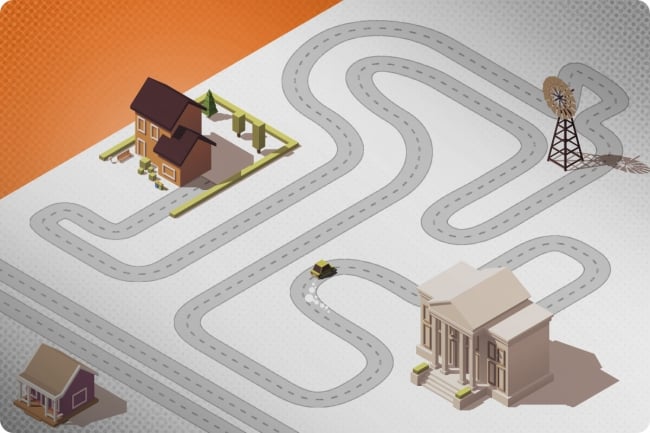You have /5 articles left.
Sign up for a free account or log in.

California students whose community college is more than 25 miles from the nearest university are much less likely to transfer than those whose colleges are closer.
Photo illustration by Justin Morrison/Inside Higher Ed | Getty Images
Two new studies emphasize the ways geography impacts access to college—and how such impacts can be especially harmful for marginalized students. Together, the studies show that living a significant distance—30 minutes in one study and 25 miles in another—from an institution of higher education is especially likely to prevent Hispanic, Black, low-income and first-generation students from getting a postsecondary education.
One of the two studies, completed by a team of economists from four universities, analyzed the pathways of high school students in Texas to see whether living far from the nearest community college was a barrier for students to enroll in higher education. For white and Asian students, it was just the opposite; living farther from a community college tended to push those students to travel out of their immediate area to attend a four-year institution. But for Hispanic, Black and low-income students, it was more likely to lead them to forgo higher education altogether.
For those students, living a half hour away from the nearest community college “is associated with lower rates of college going overall [and] lower rates of degree completion overall … suggesting that for these students, having a community college nearby could be a really important access point to higher education,” said Riley Acton, an assistant professor of economics at Miami University and one of the study’s authors.
The other study, focused on California, centered on students transferring out of community colleges. Conducted by California Community Colleges’ Research and Planning Group (RP Group), the research found that nearness to a four-year institution played a major role in whether those who completed community college went on to transfer. Students at community colleges in what the researchers dubbed “university education deserts,” or UEDs—meaning they are located at least 25 miles from the nearest four-year institution—transferred at lower rates than other community college students. The rates dropped further for colleges located at least 80 miles from a four-year university.
Low-income, first-generation and Latine—the term the RP Group uses—students were more likely to attend college in a UED, meaning that those populations are more likely to face distance as a barrier to transferring.
Possible Solutions
Distance has long been known to be a factor in students’ college-going decisions; most students go to college within 17 miles of their home. But it is often excluded from discussions about college choice, which has historically emphasized narratives of academic and social fit. At the same time, proximity is an incredibly difficult issue to solve, especially at a time when far more colleges are closing than opening.
Nevertheless, experts say new research about college proximity could open the door to innovative solutions to help students access higher education. It also demonstrates the importance of investing in the colleges—largely regional public institutions and community colleges—that are typically the only higher education offerings in their area.
“Those institutions … tend to be anchors in their regional community,” said Benjamin Cecil, a senior education policy adviser at Third Way, a think tank. “[But] they don’t always have the same resources to put towards the completion side of the equation.”
Darla Cooper, executive director of RP Group, said that any potential solutions should involve meeting students where they are—or, as she put it, “bringing the education to the students,” rather than vice versa.
That could involve implementing bachelor’s programs at community college campuses—a growing trend at two-year institutions in various regions of the country—or working to help connect community college graduates with online education that fits their needs.
But it will be easier to figure out how best to help students in UEDs transfer if they can glean more information on what, exactly, about the distance turns students off from attending faraway four-year institutions. The RP Group team intends to focus the next phase of their research on that question, Cooper said.
“What is it about the distance that is the biggest obstacle? Because it could be a lot of things. Obviously, transportation is on that list, but what other pieces? Could it be family obligations, community obligations?” she asked. “We’re planning to do more qualitative research, to go to some of these places and talk to these students … What do students tell us the actual barrier is about the distance?”
That research will also include conversations with community college students in UEDs who did successfully transfer elsewhere, with the hope of understanding what resources community colleges, universities and large communities could put in place to support those students, according to Daisy Segovia, a senior researcher for RP Group.
Acton, one of the researchers on the study of community colleges in Texas, noted that although college closures are far more common than new college openings, she hopes their research might influence how colleges and legislators make decisions about openings, closings and consolidations when they do occur.
“One of our policy implications from this is that states and individual institutions should think carefully about the population that their institution serves, and what sort of other options students would have if their particular institution were to close or to merge with another institution,” she said. “If states would like to open new community college campuses, they can think about where [states should] put those campuses to have the best results for their population.”




